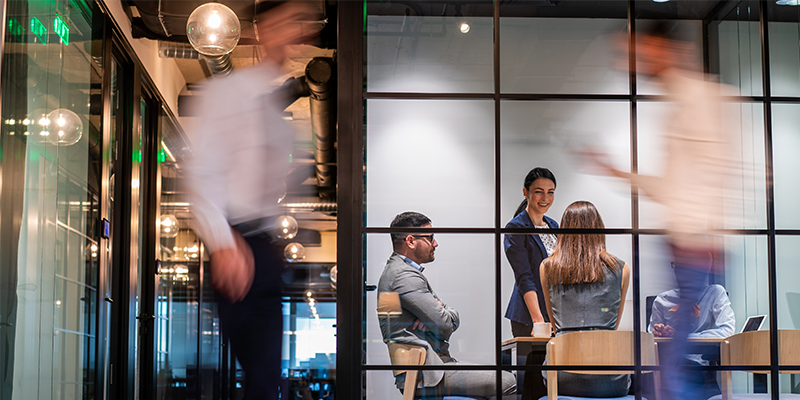The world of real estate has experienced an unprecedented level of disruption. There are changes to traditional service and business models, changing expectations of the workplace, and a heightened imperative to focus on safety, health and wellbeing.
Touchless technology, social distancing sensors and other tools are key to bringing people back to the office safely. Clients are increasingly looking to their property manager to provide the best advice and insight to help “get back to normal.”
The reality is things will never get back to “normal.” The good news, however, is that the workplace can return to a “better than normal” safe workplace.
The demand for connectivity is greater than ever before. In a survey of 3,000 office workers, JLL found that “human interactions” and a “professional environment” are what employees miss most while working remotely. To meet this need, property managers are creating personalized content and programming tailored to specific geographies, building communities and individual preferences – allowing building owners to recreate the atmosphere of the office virtually.
Building management teams are offering a menu of easy-to-deliver ideas that do not require complex organization and delivery and are tailored to suit occupier and customer preferences.
Activities can include live-streamed exercise, meditation and wellness programs; virtual happy hours; interactive webinars, tutorials and DIY projects; exclusive webinars featuring celebrity guest appearances; and culture-building activities such as trivia, in-home mixology classes and more. The programs can be accessed remotely, within the tenant space, or in one of the building’s common areas – depending on need and interest – and are designed to continually evolve with more features as demand dictates.
As the workforce slowly begins to return to the office, buildings are also offering a variety of amenities to help create a safe and welcoming environment as well as provide tenants with personalized services they might not be able to offer in-house. Tailored to each individual tenant’s needs, they can include providing:
- Food and beverage services and happy hours
- Personalized lobby greeters
- Dedicated engineering staff
- On-site office managers
- Personal concierge service
To further improve the tenant and visitor experience, many owners are also reimagining the workplace and transforming it into a hospitality-infused space much like a hotel. Through floor repositioning, office amenity activation and cohesive branding and design from floor-to-ceiling, building owners can drive an experience where employees feel more connected to the company and their fellow co-workers.
As space and opportunity allow, buildings are seeking to offer on-site COVID testing and vaccines and partner with such organizations as the American Red Cross to help meet the critical need for blood donations and COVID antibodies.
As new technology will make the greatest permanent changes to the built environment, building owners have elevated touchless smart solutions from “nice to have” to essential by installing automatic hand sanitizers and touchless visitor entry. Going a step further, tenants can access a building and its garage, call an elevator and even reserve common amenities by using an app on their phone. Touch-free entry can also be extended to visitors by enabling them to pre-register using their phone or computer prior to arrival.
The goal is to have a single app that enables occupiers to interact seamlessly with the environment by facilitating a touch-free journey from the front door to the workstation. This will ultimately become standard practice moving forward.
While touch-free technology can help reduce contact with infectious elements, technology can also lighten the cleaning load. Ultraviolet light, which has been in use for decades in hospitals, can be used to kill viruses. Self-cleaning surfaces can also be installed. Similarly, lights can be controlled by motion activation, removing the need to touch a switch, and smart restroom solutions can monitor use and track cleaning and sanitary stock.
In JLL’s latest survey of more than 2,000 office tenants, one theme is clear: Tenants expect their buildings to be focused on health and well-being. Improved air filtration systems and the availability of natural light will become mandatory for selective tenants, rather than optional. Building managers are also focusing on improving cleaning practices, air quality and water hygiene as well as making common areas (lobby, conference rooms, gyms, outdoor areas and co-working spaces) healthier.
The COVID-19 outbreak has brought a re-examination of the way office space is used. Flexibility is at an even greater premium and the need to provide corporate occupiers with flexible space solutions are increasing. As a result, investors and developers should adapt to designing, building and managing these spaces, embracing turnkey solutions delivered under management agreements.
The type and level of service does not need to be restricted to the flexible space, but can seamlessly expand throughout a building, potentially revolutionizing the workplace experience.
Connectivity is key and public transportation still matters and, as investors and companies consider their location strategies in 2021, they must question if the commutes are sustainable.
Not only are many of these preferred changes useful for slowing the spread of illnesses, but they also appear to improve employee satisfaction. COVID-19 has forced a comprehensive reevaluation of strategies and priorities, with the implications stretching far beyond real estate. Companies that embrace the potential benefits of a post-COVID-19 world could be rewarded with a more productive and engaged workforce along with greater cost efficiencies across their portfolios.














